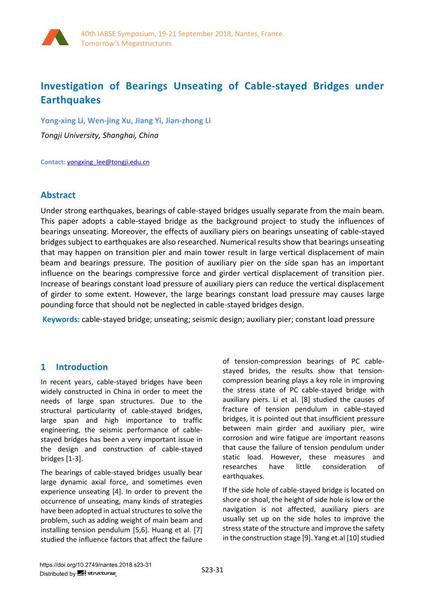Investigation of Bearings Unseating of Cable-stayed Bridges under Earthquakes

|
|
|||||||||||
Détails bibliographiques
| Auteur(s): |
Yong-xing Li
(Tongji University, Shanghai, China)
Wen-jing Xu (Tongji University, Shanghai, China) Jiang Yi (Tongji University, Shanghai, China) Jian-zhong Li (Tongji University, Shanghai, China) |
||||
|---|---|---|---|---|---|
| Médium: | papier de conférence | ||||
| Langue(s): | anglais | ||||
| Conférence: | IABSE Symposium: Tomorrow’s Megastructures, Nantes, France, 19-21 September 2018 | ||||
| Publié dans: | IABSE Symposium Nantes 2018 | ||||
|
|||||
| Page(s): | S23-31 | ||||
| Nombre total de pages (du PDF): | 8 | ||||
| DOI: | 10.2749/nantes.2018.s23-31 | ||||
| Abstrait: |
Under strong earthquakes, bearings of cable-stayed bridges usually separate from the main beam. This paper adopts a cable-stayed bridge as the background project to study the influences of bearings unseating. Moreover, the effects of auxiliary piers on bearings unseating of cable-stayed bridges subject to earthquakes are also researched. Numerical results show that bearings unseating that may happen on transition pier and main tower result in large vertical displacement of main beam and bearings pressure. The position of auxiliary pier on the side span has an important influence on the bearings compressive force and girder vertical displacement of transition pier. Increase of bearings constant load pressure of auxiliary piers can reduce the vertical displacement of girder to some extent. However, the large bearings constant load pressure may causes large pounding force that should not be neglected in cable-stayed bridges design. |
||||
| Mots-clé: |
Pont à haubans conception sismique
|
||||
